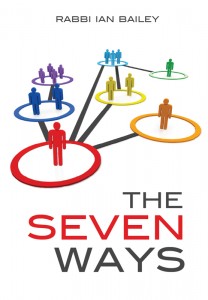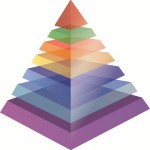Noach: Find Sefirot Throughout Your Life:
New Parallels of Sefirot & Psychology
PDF Sefirot and the Life Cycle
In honor of the Torah Portion of Noach, which details the descending ages of primary figures in the Torah, (going from 930 (Adam) and Methuselah (969) to the 120 years that G-d relegates (Gen. 6:3) to general man) I offer a newly discovered connection between the now-expanded human life cycle and the sefirot. 
Interesting Factoids
In the year 1900, the average life expectancy in the U.S. was 47 years old. Half of all parents at that time lived to see the passing away of a child; by 1976 this rate drastically reduced to 6%. Twenty five percent of children in 1900 had lost at least one parent by the tender age of 15, and one in 62 had lost both.
These statistics remind us that our country and world have changed quite a bit in the past 111 years. In 1850, only 2% of people lived to celebrate their 65th birthday, while today the number has shot up to 75 percent. With people living longer, psychologists are noticing emergent life cycle stages that contain distinctly different behaviors, psychological inclinations and stressors. I will outline the general stages below and highlight their key implications, at the end of this article, derive meaning for our lives.
An Absolute?
Psychologists are somewhat divided as to whether the shortened lifespan of previous years contained an abbreviated form of the rather distinct stages as we have them now, but there is a general consensus is that new stages have developed (McGoldrick, Carter and Garcia-Preto, 2011). These two stages have been labeled by many(1) to be Young Adulthood (Approx. 21-30) and Late Middle Adulthood (55 or 60 to 70). The former is a stage that has received much attention recently. Instead of entering the workforce in early teenagehood and marrying soon after as in yesteryear, typical Americans are still in school and launching their careers well into their late 20s, with the average age for marriage going from early 20s to mid to late 20s.
I will provide a general outline of the different stages and how they match up with the seven sefirot of kabbalah, in order. I must note that I am combining several charts into one from the aforementioned authors. I feel comfortable doing this as the charts are similar and the authors imply that they believe all of the different charts to be accurate. I also added my own observations.
Also of note is that, though life expectancy is around 75 (give or take 4 years depending upon your ethnicity and background), and that number is awfully close to being divisible by 10 to get 7 even stages, I have not yet been able to divide the stages evenly into 10 years apiece. That having been said, the theories themselves are, just that, theories; they are not restricted to exact dates or rigid timelines; not enough of their components which are based in actual studies are relegated to certain years for them to be considered rigid charts. This, and the fact that secondary middot are likely to show up in each stage and throw off the stage from being perfectly pure middot, and the fact that certain middot overlap in different texts in which they are brought (chesed/gevurah/tiferet, and especially netzach/hod) lead me not to consider it a major issue with my own theory.
This, and the fact that secondary middot are likely to show up in each stage and throw off the stage from being perfectly pure middot, and the fact that certain middot overlap in different texts in which they are brought (chesed/gevurah/tiferet, and especially netzach/hod) lead me not to consider it a major issue with my own theory.
Sefirot Life Stages
Chesed (Approx. 0-10) – Develop empathy for others; language and communication; communicate basic frustration and happiness; recognize self as separate person (like Avraham’s separation from homogeneous home life); trust others, overcome fears (both opposite of gevurah, which would be to find reasons not to trust or to be afraid); the “terrible twos”, the chesed–gevurah stage, in which children are very dependant but insistently seek independence.
Gevurah (Approx. 11-16/20) – Learn to regulate impulses, control emotion, delay gratification; obey rules; master own behavior; control anxieties (‘subduing one’s inclination’=gibor=gevurah); begin development of morality, challenging lack of fairness; express anger, fear, and pain in non-destructive ways. Increase understanding of self in relation to other people and things.
Tiferet (Approx. 16/20-21/25) – Increase skill with language; engage in cooperative abilities. Learning, reading writing, math. Increase physical skills and coordination. Better understanding of morality and more sophisticated injustices. Increase understanding of self in relation to peers, family, and community; work collaboratively and individually (balance of self and boundaries with others).
Increase physical skills and coordination. Better understanding of morality and more sophisticated injustices. Increase understanding of self in relation to peers, family, and community; work collaboratively and individually (balance of self and boundaries with others).
Netzach (Approx. 21/30-40) – Increase ability to think mathematically, conceptually, and study the world; develop philosophy of life and a moral and spiritual identity. Increase discipline to develop physical and intellectual work, tolerance to delay gratification to meet one’s goals. Develop ability to advocate for others who are less fortunate; ability to negotiate evolving relationships, including community.
Hod (Approx. 35/40-55) – Nurture and support one’s children and spouse; caretaking of elderly family members; consider changing work/career to achieve greater life balance; involve oneself in improving community and society; launching children; focus on mentoring next generation.
Yesod (Approx. 50-60) – Deepen and solidify friendships; desire to make sure family is interconnected; involve in improving community via organizing improvement projects; reassessing work/life satisfaction; more/final launching of children; tie in multi-generational families; after long career of gaining experience and skills, often finds increased success in an organization or niche area; realigning family relationship to community.
Malchut (Approx. 60-75) – Establishing a legacy; accepting death of spouse, inevitable death of self, with deep interest in current personal survival; reviewing of the events of one’s life, including plusses and minuses (the particulars being subsumed into the general concept of that person’s identity, as malchut is the solid connection of any group of particulars); renewed focus on making sure family is taken care of, rather than preoccupation with work. This is similar to Avraham in his chesed–malchut stage. Part of me thinks this whole chart is also reflected in the seven chesed-based sefirot (chesed-chesed, chesed–gevurah…chesed–malchut), as well.
Relevance and Meaning for Us and Our Communities
It is important for mental health providers, community leaders, rabbis and the like to be aware of the fact that different stages of a person’s life provide different challenges and stressors. By anticipating these stressors, one can better counsel individuals through their tough times. If we ourselves are aware of the stressors, we can be better prepared to tackle them.
In terms of the psychological manifestation of traditional kabbalistic principles, there is much meaning in discovering a greater presence of the sefirot in our world. First of all, the fact that our lives contain direct or at least more involvement in the sefirot points to something epic that is transpiring around us. Though I am not one to strongly suggest signs of a messianic era as many have (often legitimately, I will add), the fact that the sefirot are more manifest in our world and they have come quite rapidly through modern technological advancements points to something of the sort. More sefirot means more facilitation of progress and development of our world, as the sefirot are stages of development in any process.
something epic that is transpiring around us. Though I am not one to strongly suggest signs of a messianic era as many have (often legitimately, I will add), the fact that the sefirot are more manifest in our world and they have come quite rapidly through modern technological advancements points to something of the sort. More sefirot means more facilitation of progress and development of our world, as the sefirot are stages of development in any process.
In terms of psychological implications, one must apply the idea of the sefirot as a process to individual human growth. The sefirot have a distinct order, chesed to malchut. Whenever there is a process in G-d’s creation (a storyline, passing of time, the Creation story, in psychics), that process is meant to develop with every one of its parts in order. When a person passes through the sefirot stages properly, in order, without attempted or successful deviation, he or she is able to grow in a better way. The longer the stages are, the more complex they are and the more one is able to develop.
Another key lesson is to realize that, instead of overvaluing and trying to live in the young adult phase for our entire lives, we should appreciate that we are supposed to go through each stage of human development as it is handed to us.
May we embrace the new expansions in human psychology and use each unique stage to actualize our potential.
IB
References:
McGoldrick, M., Carter, B., and Garcia-Preto, N., (2011). The Family Life Cycle: Individual, Family, and Social Perspectives. Boston: Allyn and bacon
(1) One of the works that the aforementioned textbook culled fits information and phraseology from is: Borysenko, J., (1996) A woman’s book of life: The Biology, psychology and spirituality of the feminine life cycle. New York: Riverhead Books. As the title suggests, it is a theory of the structure of the human life cycle that derives its baseline structure from theories of and research into women’s life cycle development. I have not read this work and cannot vouch for it; my goal is once again to find psychological patterns of the sefirot.


Rabbi Bailey, this is a great article! It is very well written and it sumarizes very well the different stages of human life through the framework and understanding of the sefirot. You took the esoteric teachings of the sefirot and attached them to real and practical concepts that researchers in the field of psychology have observed. May you be blessed to continue to align scientific observation with the wisdom that we have received from our maker!
– Sincerely,
Dr. Joshua Leibow, ND
Thank you so much Dr. Leibow! Amen amen I hope to keep doing so, too. Rabbi B
I just ordered the book and waiting. In the meantime: talking about chesed-malchut; will you consider delving into the 7×7 cross-combinations of the sefirot? Do you think that this is a deeper way ( sub-proccess) of detailing the main sefirot? So every sefirot has 7 sub-stages in itself?
Hi Daniel,
I’m glad you posted, as this is an excellent question. It really highlights one of the main methods of learning the sefirot in using them to understand the world.
There are actually 7x7x7 (3 levels) of total sefirot, equaling 343, the gematria of GESHEM = physical realm, i.e., the building blocks thereof. Let’s use 7×7 = 49 to keep things simpler. So the question here is, are the 49 sefirot totally distinct or each outgrowths of the main sefirah (making deeper versions or sub-processes)?
The answer, in my opinion, is that each is an outgrowth of the primary sefirah. To be even more specific, each is an aspect of the main sefirah. For example, compare and contrast chesed shebtiferet with hod shebtiferet. They are the chesed within tiferet and hod within tiferet, meaning that aspect within the primary sefirah (yes, the primary sefirah is second in the wording order-it’s confusing). Let’s take one major component of tiferet: creativity. Chesed within tiferet can mean “expansiveness-lack of definition/explanation within creativity”, which would be brainstorming or absorbing information at the beginning of the creative process. Indeed, at the beginning of Yaakov’s live, the time that matches up with chesed shebtiferet, he is studying in his tent. Hod within tiferet would be emotions and relational content within art, which may be art therapy or the emotions that are evokes, or perhaps some drama therapy. This matches up with him speaking with his wives about their feelings, with animals in the background as evoking feeligns about their father abusing them financially.
Furthermore, the sefirot are sequential, even with this idea in mind. Netzach shebtiferet includes the aspect of analyzing a lot of information to put into an invention or piece of creativity, and this can bog down a person. The next sefirah, hod shebtiferet, comes along to remedy this by adding more emotion and relational aspects.
With this in mind, however, when one is contemplating the sefirot I think that it is fruitful to keep reminding oneself a tiny bit of the opposite:t each combination of the 343 is a distinct sefirah (ideas, descriptions, etc) that exist. Delving into the main 7 yields general, yes distinct ideas, and viewing them as separate will help you flesh out distinct ideas (brainstorming vs emotion-evoking) but the combinations are all aspects of the primary 7. Also, the 343 exist int he story line of the 7 figures in the Torah, so chesed-tiferes of Yaakov has 7 steps within that. Him contemplating, making a move, etc.
I hope this answers your question clearly. Feel free ask more questions in general or about this topic.
My book is primarily about personality typing, heightening self-awareness, and improving interpersonal relationships. But the sefirot are the building blocks for all science and components of the universe, philosophy, etc., even for psychotherapy, which is my current field. Also, I am collaborating with people in different fields, but this is taking time. If you have a specific field or and ideas from this material I’d like to hear it.
All the best,
Ian